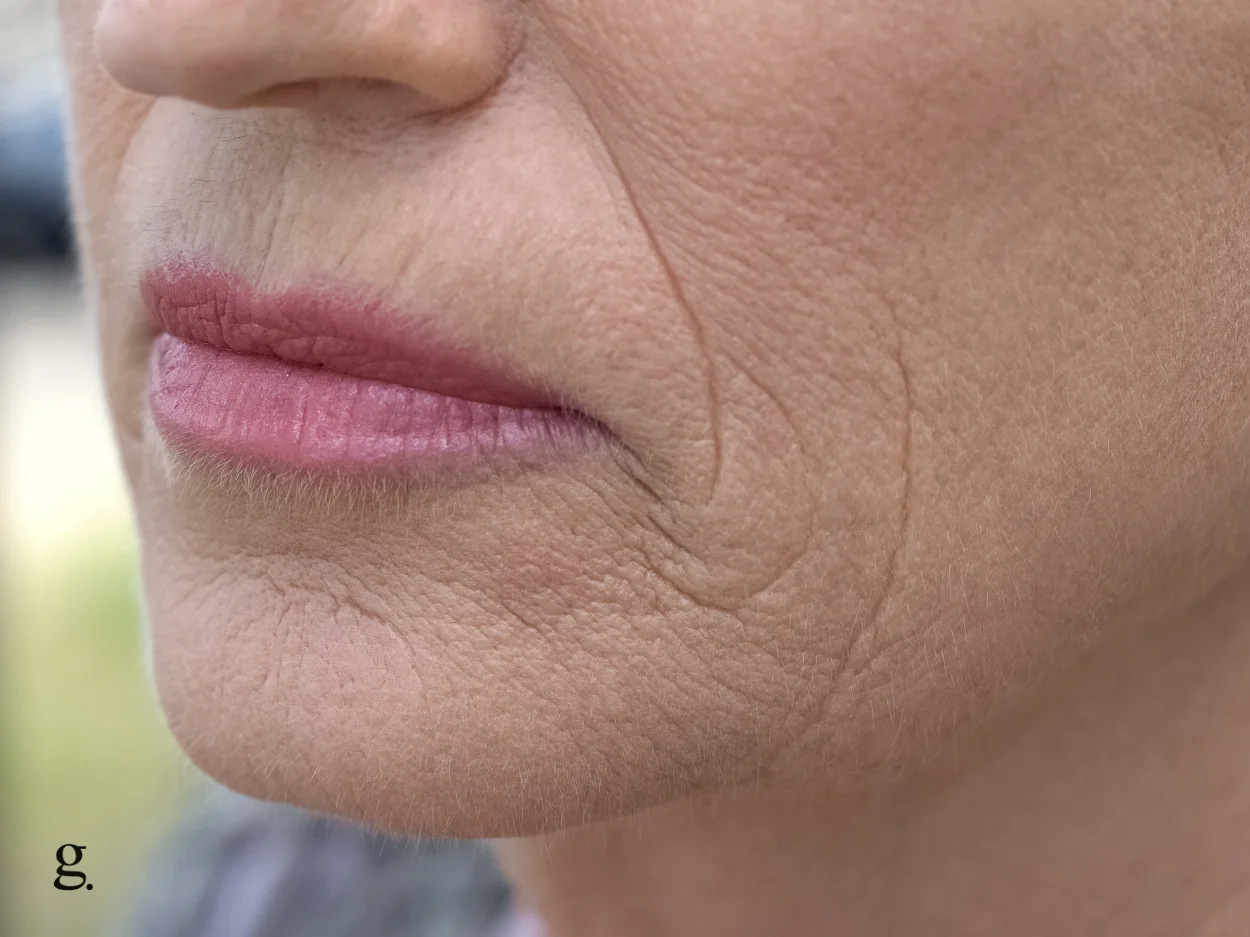We’ve all seen them and, chances are, we all have them: fine lines. Those pesky little wrinkles that usually show up under your eyes, around your mouth, and on your forehead.
Fine lines are the dreaded early signs of aging – a little note from Father Time, letting you know he hasn’t forgotten about you!
Before you freak out, not all is lost; there are plenty of things you can do to dispatch fine lines tout suite.
The difference between fine lines and wrinkles
While wrinkles tend to be deeper and more visible, fine lines are usually much smaller and not as noticeable. They’re essentially the beginnings of wrinkles and can become more pronounced and visible over time.
As we age, our skin changes (typically for the worse) and becomes drier and less elastic. This is due to a breakdown in collagen and elastin levels in the skin, which are the proteins responsible for keeping the skin looking plump and youthful.
Fine lines are often one of the first signs of aging skin and can appear around the eyes (crow’s feet), on the forehead, or around the mouth (though it’s not unusual to find them on your body too, especially around your chest and neck).
The main causes of fine lines
When it comes to wrinkles, their causes are pretty well known: aging, sun damage, and smoking.
All of the above causes wreak havoc on your skin, causing a decrease in collagen. Over time, this reduction in collagen starts to visibly show, and manifests itself in the forms of fine lines, which may go on to become deep wrinkles.
They can also pop up due to extreme dehydration, which can cause the body to draw water out of the skin, causing it to wrinkle and crease much easier – this is typically fixed by upping your water intake.
Finally, certain repeated facial expressions, such as squinting or frowning (which is why we always stress the importance of sunglasses on sunny days, to prevent squinting).
Ways to get rid of fine lines
When it comes to treating fine lines, you have three main options, each getting progressively more “extreme”.
Using a skincare product, getting a skin treatment, or going under the knife and getting a face-lift.
Using an anti-aging or anti-wrinkle skincare product should be the first port of call for anyone looking to reduce the visibility of their fine lines. While the formulas in these products can differ largely, they typically all use similar ingredients.
The best skincare products for getting rid of fine lines are ones that contain proven active ingredients in potent doses.
The most effective skincare ingredients for fine lines
Below we’ve listed all the best science-backed ingredients to look out for in skincare formulas:
Topical Vitamin C
Not only does Vitamin C brighten the skin, but it also acts as a shield against outside pollutants and boosts collagen creation.
By using vitamin C topically, you can help improve your skin’s appearance in numerous ways, such as evening out skin tone and reducing the visual appearance of fine lines and wrinkles. Topical vitamin C has also been shown to help with skin conditions such as acne.
Vitamin C is an excellent choice for all skin types, including those with sensitive skin, due to it being very well tolerated overall.
Retinol
Retinol is an anti-aging topical ingredient that is derived from vitamin A. It helps improve the appearance of wrinkles, fine lines, and skin texture by increasing cell turnover and stimulating collagen production – this renewing effect is why it’s arguably one of the most popular skincare ingredients ever, being used in hundreds of thousands of products worldwide for its rejuvenating properties.
The only drawbacks to retinol are that it can be irritating to those with sensitive skin, can dry out skin, and makes the skin more sensitive to UV rays, so always use sunscreen during the day when using products containing retinol, and use a good moisturizer right after applying it.
Niacinamide
Niacinamide is a form of vitamin B3 that is often used in skincare products, and for good reason – it’s a powerful ingredient that can help to improve the appearance and health of your skin.
Niacinamide can help to reduce hyperpigmentation, even out skin tone, and make the skin more elastic overall. It also helps to reduce the visibility of fine lines and wrinkles, in addition to supporting the skin’s natural barrier function (this means that it can help prevent moisture loss and keep environmental pollutants out of the skin).
Peptides
Peptides are chains of amino acids that are used in the creation of proteins, commonly used in topical skincare products like anti-wrinkle creams and serums.
Because collagen protein molecules are way too big to be absorbed by the skin, peptides are popular because they’re the next best thing!
As they are small in molecular size, they can easily sink into the skin to provide a variety of benefits. One of the most important functions of topical peptides is to stimulate collagen and elastin production. This helps to plump and fill out the skin, which can make fine lines and wrinkles appear reduced.
Hyaluronic acid
Hyaluronic acid, or what’s often called hyaluronan or HA, is something that already exists in your body naturally. It’s found most abundantly in the skin.
Our body makes hyaluronic acid to help the skin retain moisture; when we are young, our skin contains high levels of hyaluronic acid which helps keep our skin hydrated, plump, and youthful-looking. However, as we age, our body will gradually produces less, which causes the skin to look dehydrated – this combined with the body also producing less collagen spells disaster for your skin.
Anti-fine line and wrinkle products that use hyaluronic acid topically leverage its ability to penetrate the skin (due to its low molecular weight), and use it to help replenish the skin’s natural levels, this improves the appearance of fine lines and wrinkles, at least temporarily.
Skin treatments for fine line prevention
If skincare products don’t do the trick, you may wish to opt for treatments, which are usually carried out by professionals.
Treatments are usually looked at as a slightly more “extreme” measure for treating fine lines, but they are beneficial nonetheless and can usually offer longer-lasting results.
The most common treatments for fine-line prevention are:
Microneedling
Microneedling is a collagen induction therapy that uses small needles to create tiny punctures in the skin. This may sound bad, but the micro-injuries caused by the treatment help prevent and suppress fine lines by stimulating collagen and elastin production – two essential proteins for youthful-looking skin.
Treatments can cost anywhere from $100 to $1000 per session, and while there is some downtime associated with the treatment (the skin will usually be red and slightly swollen for a day or two afterward), the results are usually very impactful.
Laser skin renewal
Laser skin renewal is a catch-all term for a variety of different laser treatments that can be used to improve the appearance of the skin.
The most common laser treatments used for fine line prevention are ablative and non-ablative lasers.
Ablative lasers work by vaporizing the outermost layer of skin (epidermis), which stimulates collagen production and can help to improve the appearance of fine lines and wrinkles.
Non-ablative lasers work by heating the deeper layers of skin (dermis), which also helps to stimulate collagen production.
Both types of laser treatments can be quite effective for reducing the appearance of fine lines, but ablative lasers tend to offer more dramatic results.
There is usually some downtime associated with ablative lasers, but non-ablative lasers usually have very little recovery time.
Botox injections
Botox is a popular cosmetic treatment that uses a neurotoxin to temporarily paralyze the muscles in the face (though botox in other parts of the body like the neck is also quite common).
The reason botox is effective for preventing fine lines is that it helps to partially paralyze the muscles in the face that can cause them. By preventing them from moving, Botox can help to stop fine lines and wrinkles from ever forming, or at least make them less noticeable.
Treatments typically last around 3-6 months before they need to be repeated.
Surgery
Going under the knife is probably one of the most drastic things you could do to get rid of fine lines, but it is an option.
There are a few different types of surgery that can be effective for treating fine lines and wrinkles, but the most common is a facelift.
A facelift is a surgical procedure that helps to tighten and lift the skin on the face, which can help to improve the appearance of fine lines and wrinkles.
While surgery is usually quite effective, it is also very expensive and comes with a long recovery time, so it is not usually recommended unless other methods have failed.
Conclusion
Fine lines are usually the precursor to wrinkles and are a completely normal part of the aging process, but that doesn’t mean you have to just accept them.
There are several different things you can do to prevent fine lines from forming or at least make them less visible.
Topical skincare products, treatments, and even surgery can all be effective, but we highly recommend you start by using anti-wrinkle products (with effective ingredients like retinol, peptides, niacinamide, vitamin C or hyaluronic acid) before you move onto other alternatives.

